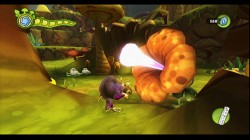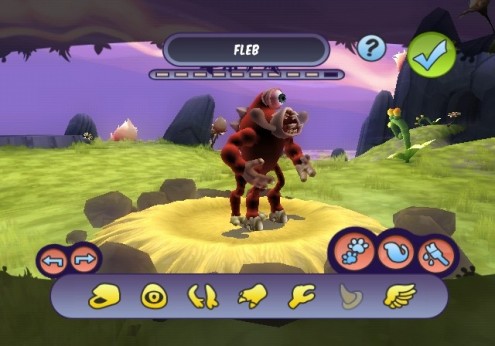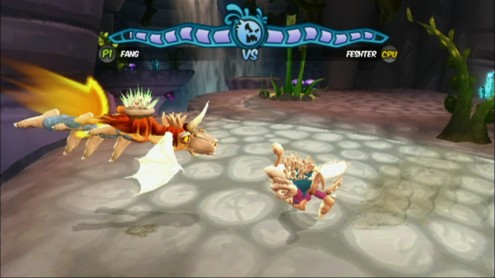Once upon a time, there was a nice colorful peaceful planet filled with nice, colorful, peaceful creatures who liked to sing, dance, and fight for sport – until one day, twin meteors fell from the sky, crashing on the planet surface. One meteor brought an evil presence set on corrupting the planet – the other brought a small, charming, heroic creature whom would always live in the shadow of his older brother.
As the console follow up to a cross-genre PC title often referred to as a “landmark,” “amazing accomplishment,” or “revolution in social gaming and user created content,” Spore Hero lives in a rather large and dark shadow – leaving it open to judgment before the critic even opens the game’s case. The problem with this prejudice is that Spore Hero is not the PC game Spore, and it’s not trying to be.
Although I maintain it’s important to keep your ideas about Spore separate from Spore Hero, one can’t analyze the came without looking at the similarities. What makes Spore Hero what it is also happens to be what makes Spore, Spore. Like it’s predecessor, Spore Hero’s claim to fame lies in it’s creature editor – rather than giving the player a studio designed avatar, players create, design, and bring to life their own “Spore Hero” with which to explore the world. Although this creature editor is somewhat limited compared to it’s PC counterpart, it still offers an unprecedented level of character customization for a console game. Throughout the game you collect more parts, upgrade your creature to access new areas or obtain more moves in battle – it’s an essential and fun part of the game – and in some ways the only thing that keep it unique in what is otherwise a pretty standard, although not bad platforming/exploration experience.
The storyline and concept of Spore Hero starts off fairly simple: two meteors fall from the sky – one carries a good guy and blue rocks to the planet, the other a bad guy and red rocks. These Fragments corrupt the local creatures, and the player is the only one that can destroy them and stop the evil creature that is spreading their corruption. From here out, the object of the game is pretty simple: collect enough blue rock fragments to build a more complex creature, and talk to the inhabitants of the planet to get missions, leads on where you can find more red rocks to destroy, and new body parts for completing tasks. Every now and then your rival will show up to tell you that you’ll never ever stop him, and then you move on and continue to explore the world.
 For the most part, Spore features the “open world environment” that’s become so common in games today – there are no “levels” to speak of, and you are free to explore any area you can reach. Some portions of the game world are blocked off by water or cliffs that you won’t be able to traverse until you acquire fins to swim or wings to glide, or until you learn a charge attack that destroys boulders. As you progress, you’ll meet creatures that need your help liberating friends from the plague of the red fragments, reunite them with their tribe, help them collect pieces of the statue of their idol, fight other monsters who are making a niceness of themselves, or simply sing and dance with them for fun. Most of these tasks are handled in their own interactive environment.
For the most part, Spore features the “open world environment” that’s become so common in games today – there are no “levels” to speak of, and you are free to explore any area you can reach. Some portions of the game world are blocked off by water or cliffs that you won’t be able to traverse until you acquire fins to swim or wings to glide, or until you learn a charge attack that destroys boulders. As you progress, you’ll meet creatures that need your help liberating friends from the plague of the red fragments, reunite them with their tribe, help them collect pieces of the statue of their idol, fight other monsters who are making a niceness of themselves, or simply sing and dance with them for fun. Most of these tasks are handled in their own interactive environment.
Combat, singing, and dancing take place in an “arena battle mode.” Combat is somewhat timing based – you can dodge around your enemy in a Tekken style arena and attack him with a Varity of moves which are defined by what parts you chose in your character creation mode. For the most part all of these moves will hit unless your opponent dodges or is mid-way through executing a move himself- so timing is crucial. The result is relatively fun and welcome departure from the exploration portion of the game – although it’s a bit simplistic. Singing and dancing feel more like busywork mini-games, requiring the player to tilt the Wii-Remote up at a particular time or drum the nunchuck and remote to the beat in the correct order. Both are good for completing quick missions to get some extra parts, but neither are memorable and remain more tedious than fun.
- 1 2



